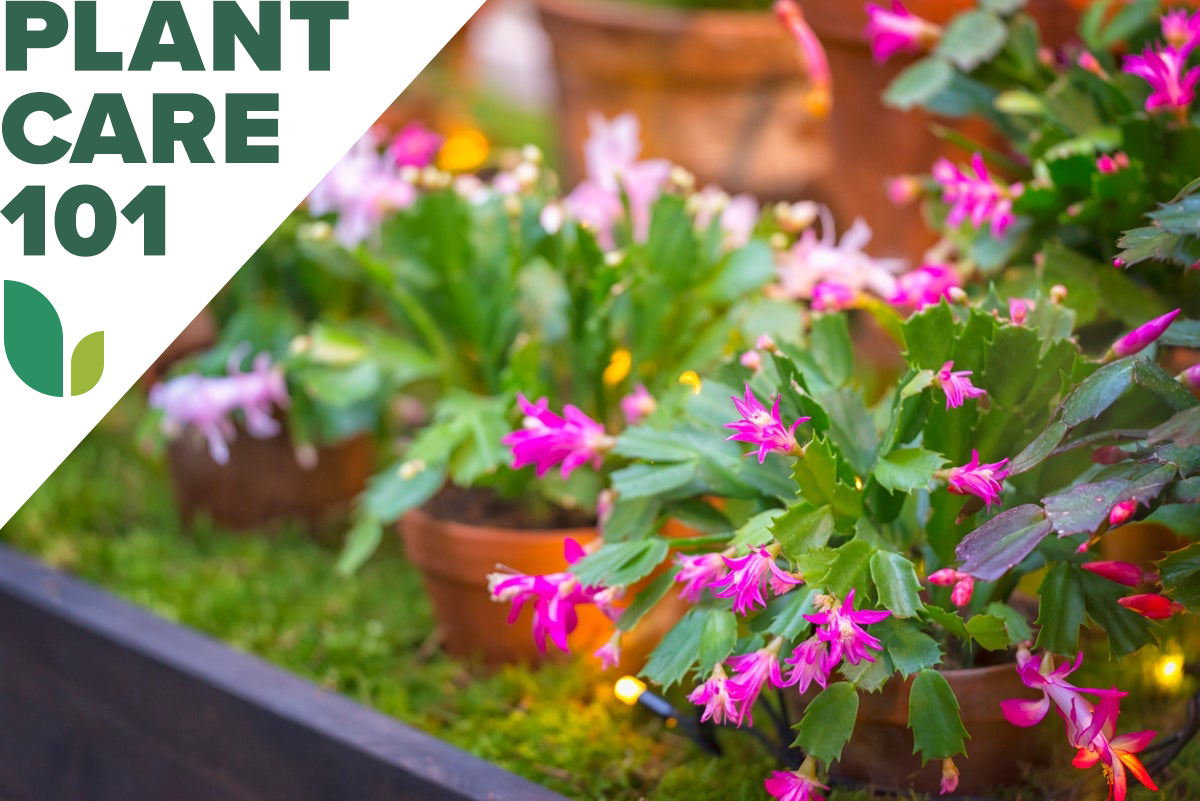

We may earn revenue from the products available on this page and participate in affiliate programs. Learn More ›
As detailed in Christmas Cactus Vs. Thanksgiving Cactus, both of these holiday plants can fall under the category of Christmas or holiday cactus and can bloom in early winter. And both tend to shed buds when moved from the original location in which they set their buds.
That can’t always be helped since few gardeners have household conditions similar to those in a professional grower’s greenhouse. Fortunately, if you keep your plant thriving during the months after you purchase it, you can nip in the bud its bud-shedding propensities during the following years. Christmas cactus care isn’t difficult once you understand that the succulents’ requirements vary with the seasons.
Christmas Cactus Care at a Glance
Common Name: Christmas cactus, Thanksgiving cactus
Scientific Name: Schlumbergera hybrids
Soil: Standard or cactus potting mix
Light: Bright, indirect
Water: Medium in summer, drier in winter
Food: Balanced and high phosphorus food
Temperature and Humidity: Warm summer, cooler winter, humid
Propagation: Stem cuttings
Safety: Nontoxic but potentially irritating
Christmas Cactus Characteristics
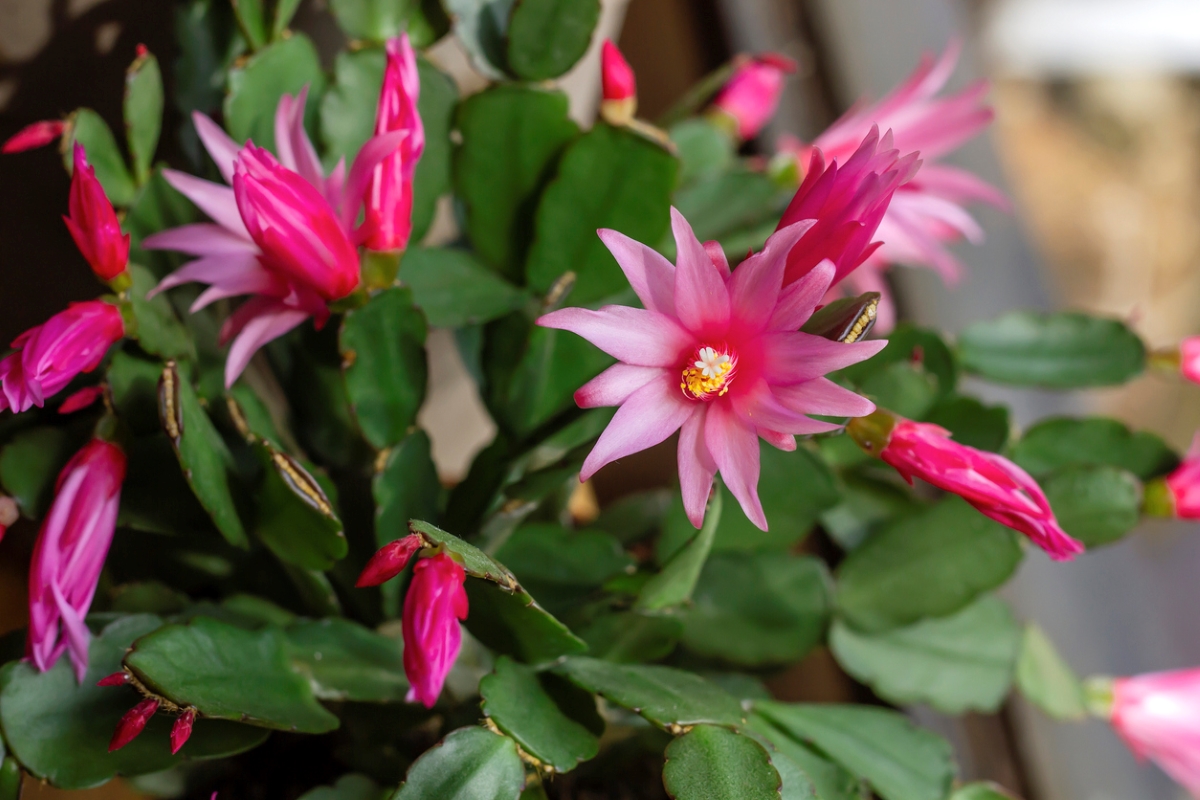
Like some orchids, Christmas cacti grow on trees in Brazilian rainforests. They generally don’t surpass 1 foot in height and 2 feet in width, though some of the oldest specimens may grow much more massive. In addition to scalloped segmented stems called cladophylls, the traditional Christmas cactus (Schlumbergera x buckleyi) produces dangling flowers in pink or red.
The Thanksgiving or crab cactus (Schlumbergera truncata), the type most often sold as Christmas cactus these days, has claws rather than scallops decorating its cladophylls. It also produces more upward-facing flowers in a wider variety of hues than the traditional type does. Modern Christmas cactus colors can include white, purple, orange, and yellow, in addition to red and pink.
RELATED: How to Increase Humidity for Your Houseplants, Even During the Driest Days of Winter
Types of Christmas Cactus
- Schlumbergera russelliana: One of the parents of the traditional Christmas cactus, this species which blooms in late winter has claw-free stem segments and dangling pink blooms up to 2 inches long, but most often is crossed with truncata in modern cultivars.
- Schlumbergera truncata: Also known as the Thanksgiving cactus for its late autumn bloom and one of the parents of the heirloom Christmas cactus, this species has upward-facing stems. Its 1- to 3-inch-long blooms and clawed stem segments come in a wide variety of flower colors and this type often is crossed with S. russelliana to produce new hybrids.
- Schlumbergera x buckleyi: This cross between S. truncata and S. russelliana was the original 19th century Christmas cactus, with pendant red or pink blooms up to 3 inches long and scalloped stem segments; it seldom is offered commercially today.
Selecting Soil for Christmas Cacti
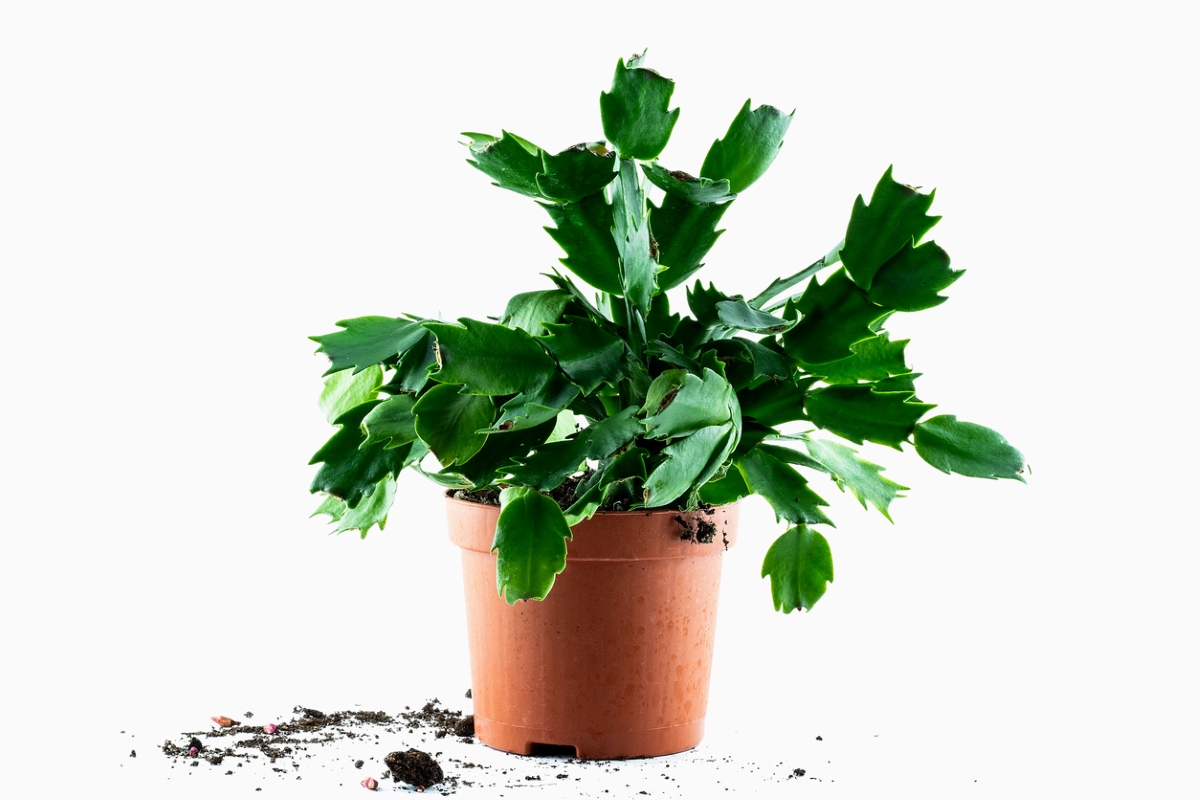
Christmas cacti generally will thrive in a standard potting mix with a pH between 5.5 and 6.5. However, if you tend to overwater your plants, you might want to choose a cactus potting mix instead.
Alternatively, you can supplement the standard potting soil with additional perlite, sand, or orchid bark to help promote good drainage and prevent root rot. The Missouri Botanical Garden’s suggested formula for Christmas cactus soil includes two parts of peat moss, one part of standard potting mix, and one part of coarse builder’s sand or perlite.
As for repotting Christmas cactus, do that only about once every 2 or 3 years since the plant won’t be as likely to rot if kept slightly rootbound. Pots for succulents always should have drainage holes to prevent water from building up in the soil.
The Right Light
Keep in mind that Christmas cacti typically grow beneath the canopy of the rainforest and give them bright, indirect light or only filtered sun for most of the year. Mild morning sun usually won’t harm the plants and often is considered the equivalent of bright, indirect light, but avoid placing them in harsher midday or afternoon rays except during winter.
The Christmas cactus light requirement for forcing the plant to set buds in fall is 6 to 8 weeks of receiving only 10 or 11 hours of light each day followed by 13 to 14 hours of complete darkness every night. You either can cover the plant every evening, beginning in mid-September, or place it in a room that isn’t used after sunset and remains dark naturally. Alternatively, keep the plant outdoors late enough in autumn that the longer nights and falling temperatures will spur it to set buds (in the warmest growing zones).
Watering Christmas Cacti
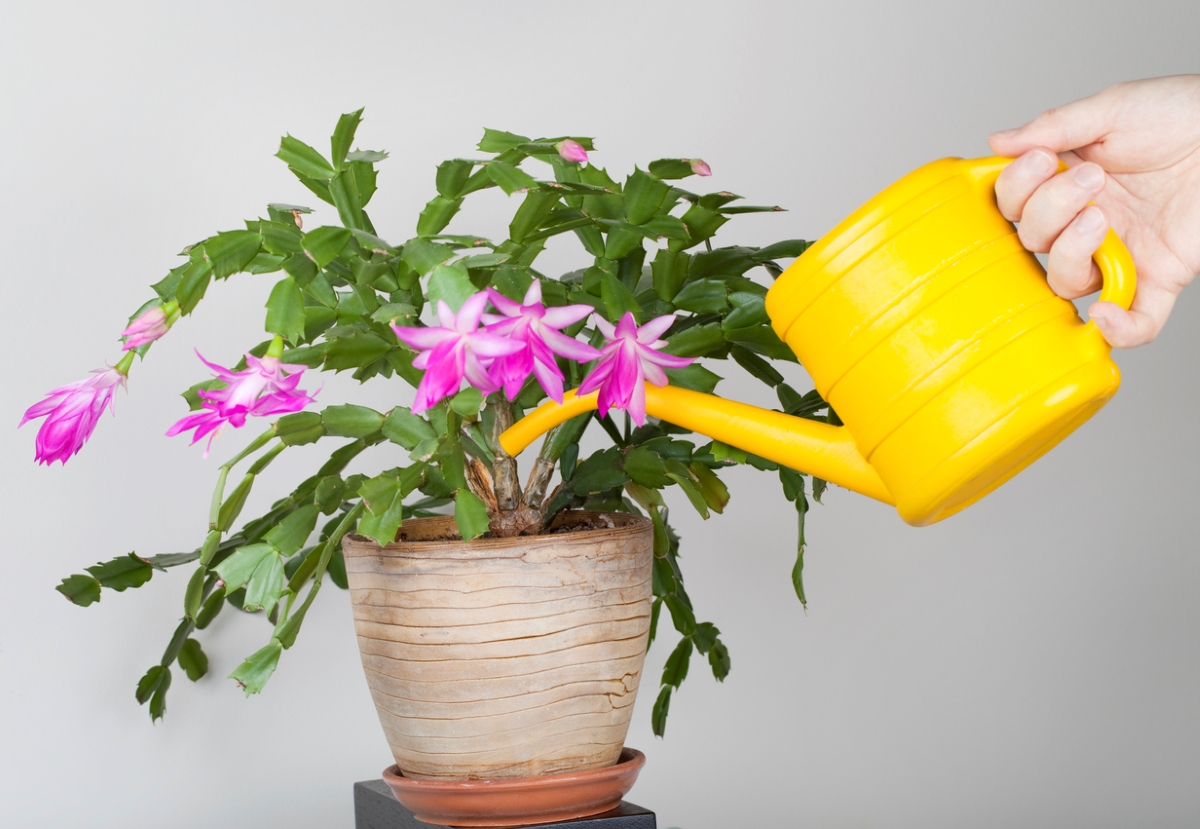
During spring and summer, water the plant’s soil whenever the surface of the soil feels dry to the touch. During autumn, cut back on the amount of water the plant receives during its long-nights period, but don’t allow it to dry out completely. Once it sets buds, return to watering Christmas cactus normally until after it stops blooming.
Then cut back on the water a bit again after blooming, especially if you give the plant the chilly rest period, which some sources recommend for late winter and early spring. After the plant begins to grow again in spring, resume watering as usual.
Fertilizing Christmas Cacti
Fertilize the plants once every 2 weeks during spring and summer with a balanced plant food such as 20-20-20 at half strength. In autumn, switch to a high phosphorus, low-nitrogen type such as 0-15-10. To provide the plants a rest period, refrain from feeding them after they have finished flowering until their growth resumes again in spring.
Clemson Cooperative Extension suggests that you supplement the cacti’s fertilizer with magnesium (Epsom salts) once per month during spring and summer. Mix only 1 teaspoon of the salts into a gallon of water and don’t apply them at the same time you apply the balanced plant food.
Setting the Temperature and Humidity
In spring and summer, a holiday cactus prefers temperatures between 70 and 80 degrees Fahrenheit. During early autumn, keep the plant outdoors, if possible, so that it experiences shortening days and cooling conditions, which will encourage it to set buds. Once you move it indoors, place it where it receives daytime temperatures between 65 and 70 degrees and nighttime temperatures between 55 and 65 degrees. After the plant has finished flowering, you may want to provide it a rest period at 55 to 60 degrees until spring.
Like most rainforest species, this one prefers plenty of moisture in the air, but usually will tolerate normal household humidity levels. To provide higher humidity, you can place it in a bathroom, near a sink, on a humidity tray, or grouped with other plants.
Propagating Christmas Cactus
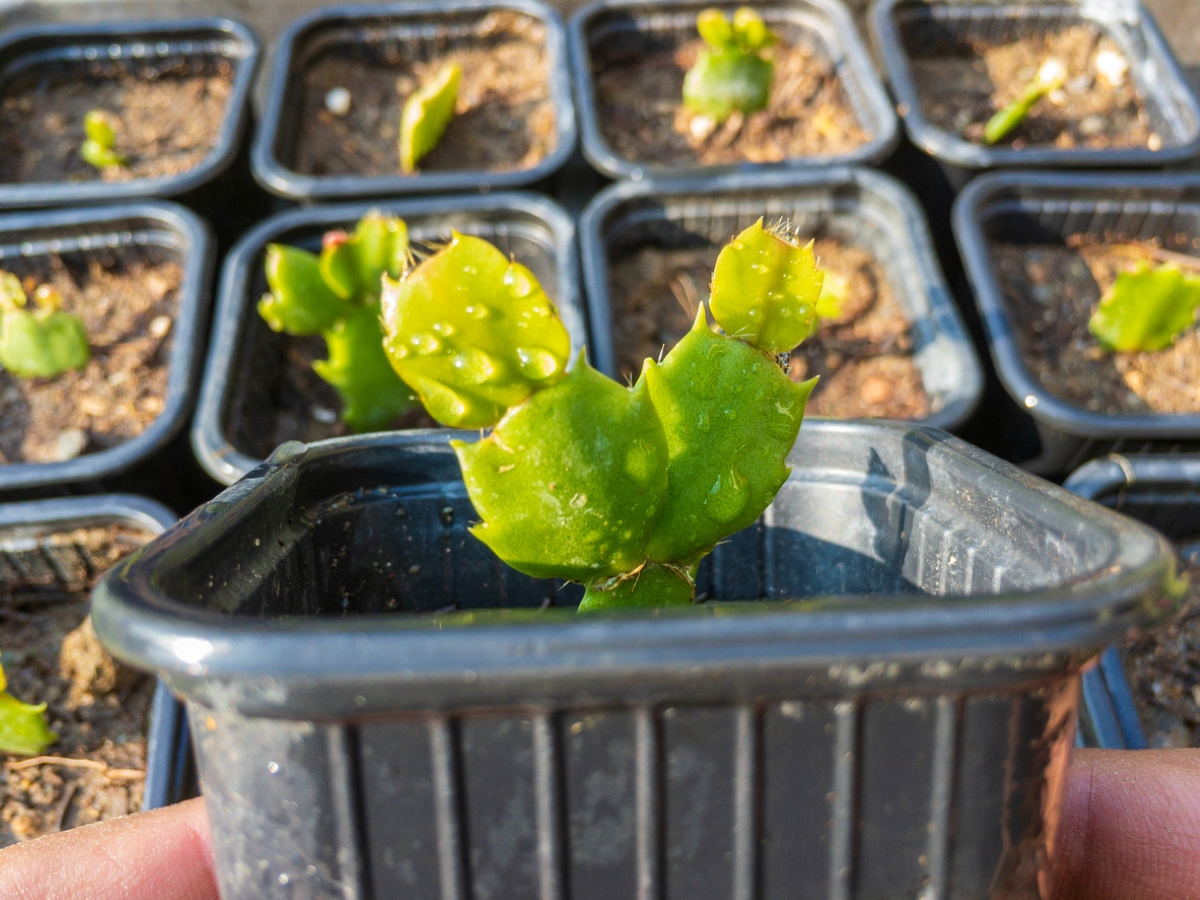
For Christmas cactus propagation, try rooting stem cuttings in early summer. After taking cuttings made up of two or three stem sections each, allow the stems to dry for at least 24 hours. Then pot them in a sterile medium such as the Royal Horticultural Society’s suggested half seed-starting mix and half sharp (builder’s) sand.
Insert the base of each cutting about ½ inch into the mix, so that the cutting stands upright. After you have finished, place the pot in a location out of direct sun at temperatures between 65 and 75 degrees. Keep the mix lightly moist until the cuttings root, which can take from 3 weeks to 3 months.
Safety Considerations
Christmas cactus is not poisonous to either people or pets. However, according to “Small Animal Toxicology” by Michael E. Peterson and Patricia A. Talcott, it can irritate pets’ stomachs if consumed, potentially causing vomiting and diarrhea and a lack of coordination in cats. Although those symptoms should subside quickly in otherwise healthy animals, you can prevent them altogether by keeping the cactus out of your pets’ reach.
Schlumbergera also has been known to generate allergy symptoms and hives in people—usually in nursery workers who handle a large amount of the plants. So, especially sensitive persons may want to stay on the safe side by wearing gloves if they need to prune the cactus or remove withered blooms.
Potential Pests and Diseases
Christmas cactus problems generally center around failure to bloom or root rot. Suspect the latter if the segmented stems appear droopy even when the soil is damp. Consult What Does Root Rot Look Like? for step-by-step directions on how to save the plant. If all of its roots have decayed, you still may be able to root cuttings from the tips of the plant. (See “Propagating Christmas Cactus” above.)
You usually can force Christmas cactus bloom by following the recommendations above regarding autumn temperatures and light requirements. Just be very careful that the plant isn’t exposed to conditions above 90 degrees after it has set buds.
RELATED: 13 Types of Cactus Plants You Can Grow at Home
FAQ About Christmas Cactus Care
Check out the section below for answers to some of the most asked questions on how to care for a Christmas cactus. If you need more extensive information on forcing the plant into bloom in the years after you purchase it, consult the sections on light, watering, and temperature above.
Q. Are Christmas cacti poisonous to cats, dogs, or other common house pets?
No. Christmas cacti plants are not toxic to household pets, but they can cause stomach irritation if consumed.
Q. Where should I place a holiday cactus in my house?
Choose a location where the plant receives bright indirect light or only morning sun.
Q. Why are the leaves on my Christmas cactus limp?
Limp “leaves” (actually stem segments) can indicate that the plant has been underwatered or has been overwatered and developed root rot as a consequence.
Q. What is the lifespan of a Christmas cactus?
Christmas cacti have been known to live for 100 years or more, though the average lifespan is 5 or 6 years.
Q. What should I do with a Christmas cactus after it blooms?
Either provide it with a cooler, drier rest period until spring or treat it as you would any other houseplant.
Q. Where can I buy a Christmas cactus?
Many department stores and garden centers sell modern Christmas cactus cultivars during the holiday season, but you may need to obtain cuttings of the seldom-offered heirloom type from a friend.
Looking for more flowering houseplants? Check out our guides on caring for bird of paradise, goldfish plant, and peace lily.
